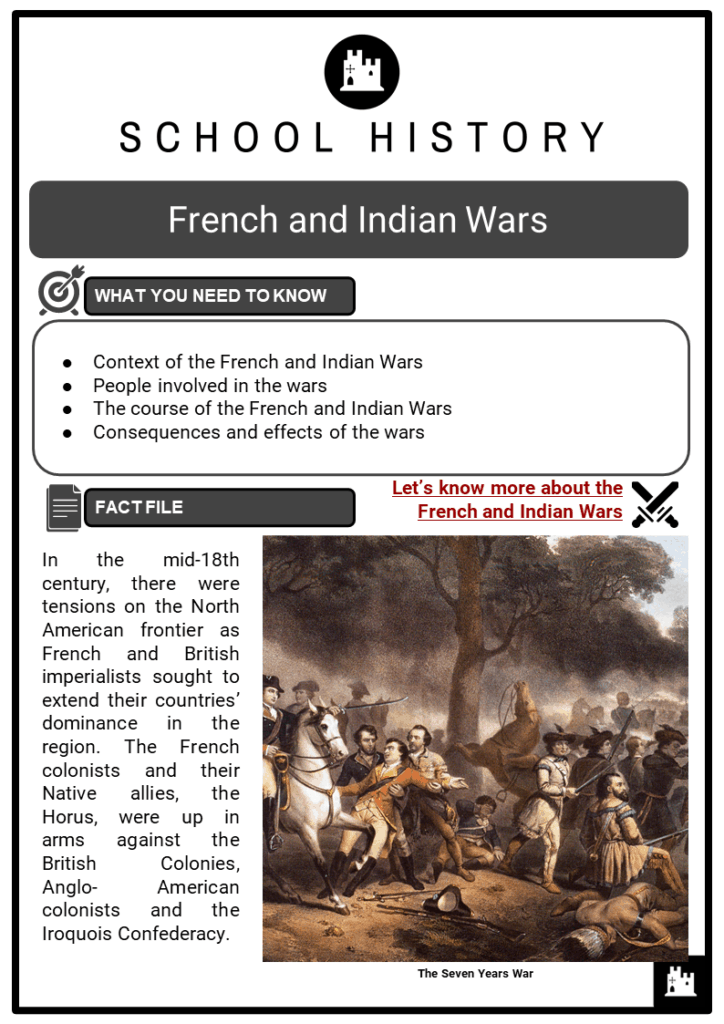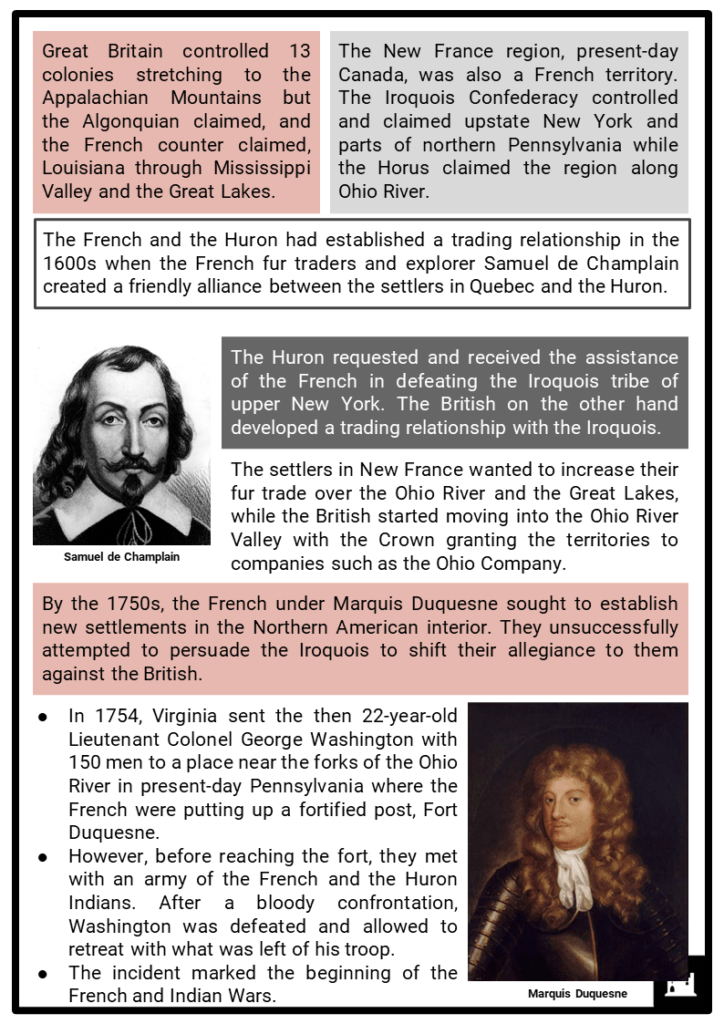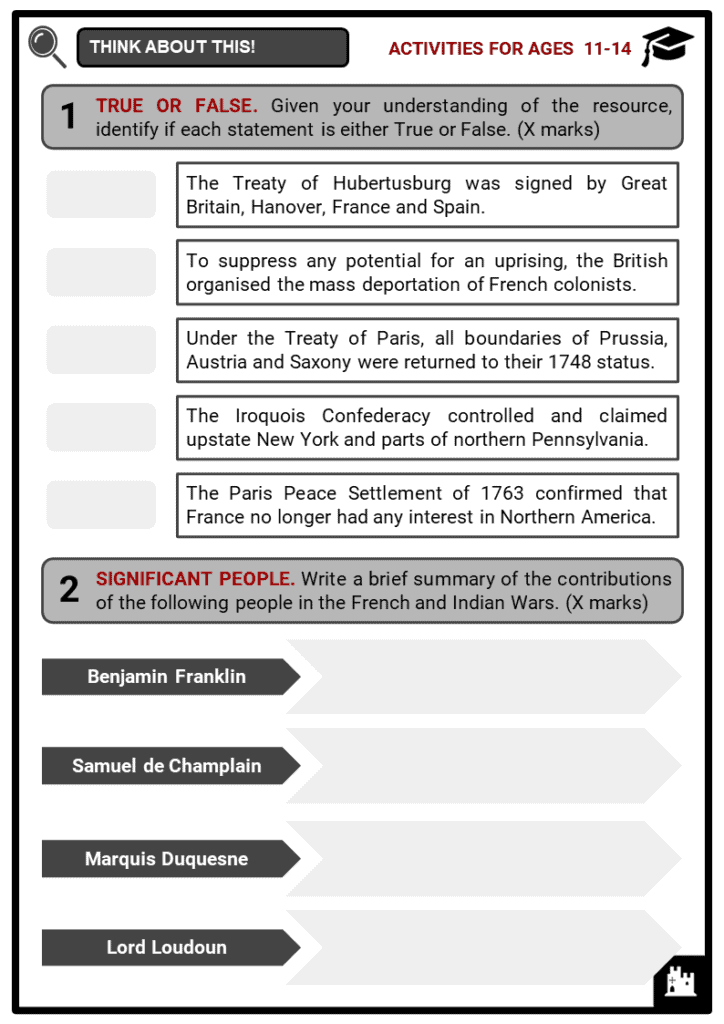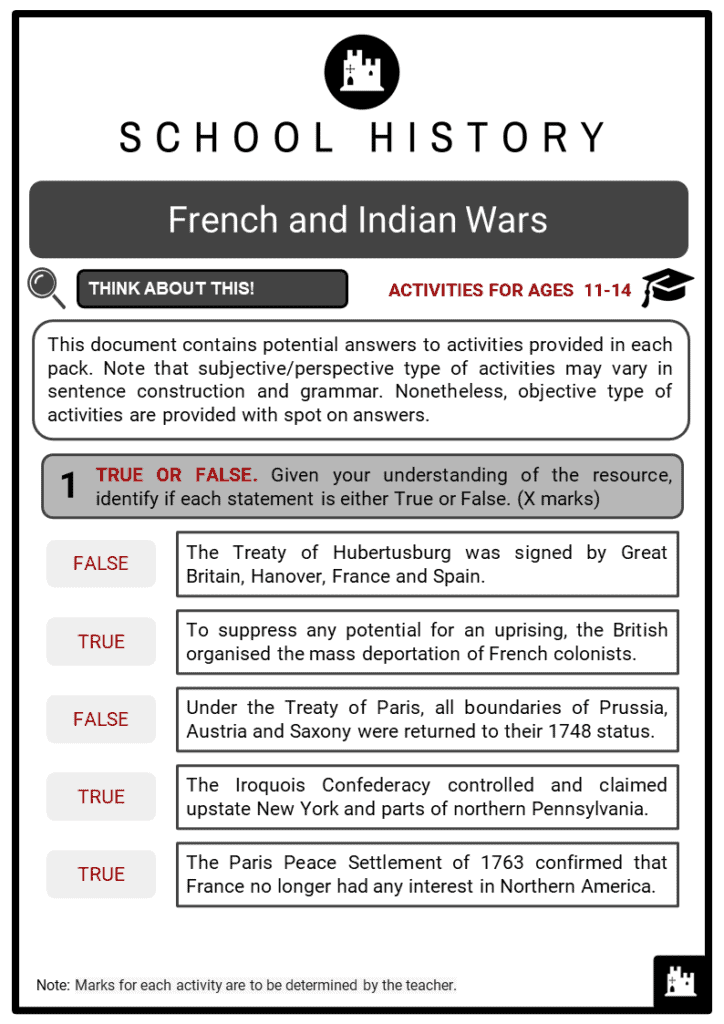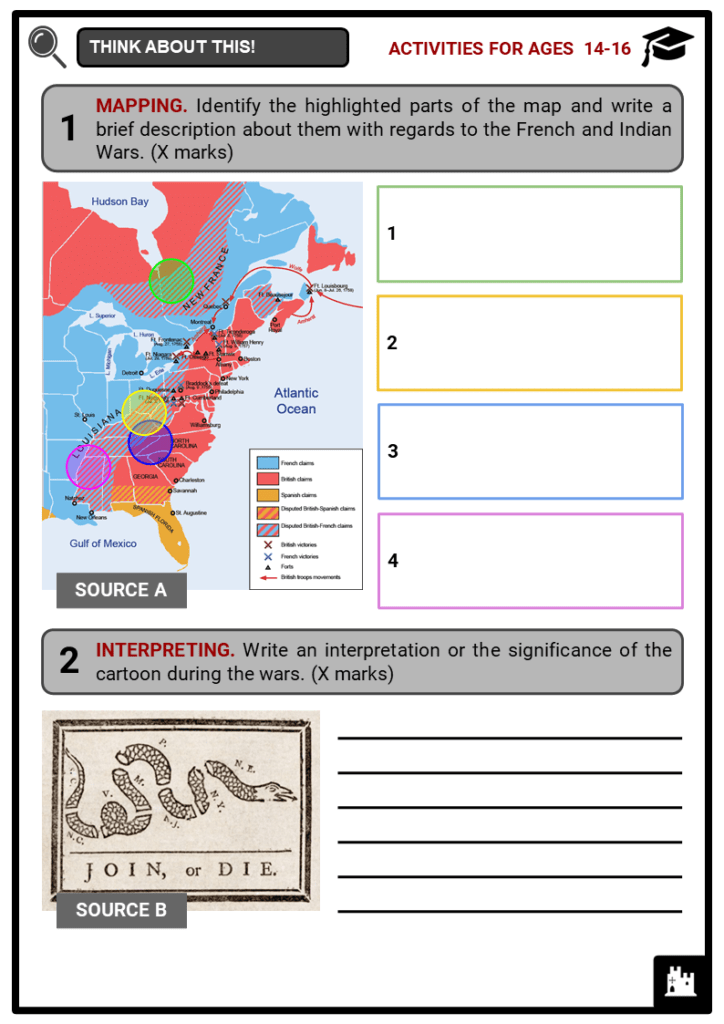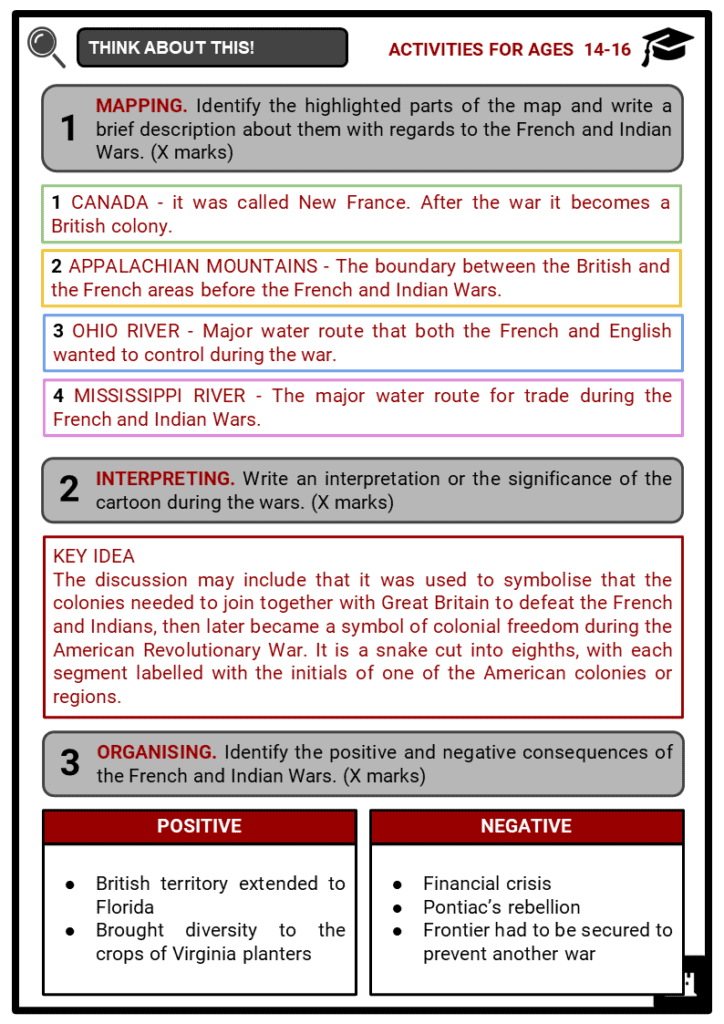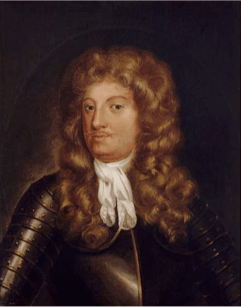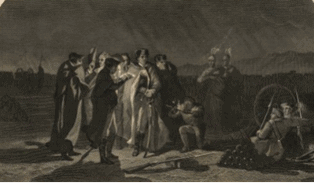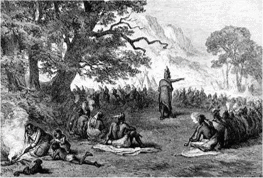Download French and Indian Wars Worksheets
Do you want to save dozens of hours in time? Get your evenings and weekends back? Be able to teach French and Indian Wars to your students?
Our worksheet bundle includes a fact file and printable worksheets and student activities. Perfect for both the classroom and homeschooling!
Table of Contents
Add a header to begin generating the table of contents
Summary
- Context of the French and Indian Wars
- People involved in the wars
- The course of the French and Indian Wars
- Consequences and effects of the wars
Key Facts And Information
Let’s know more about the French and Indian Wars
- In the mid-18th century, there were tensions on the North American frontier as French and British imperialists sought to extend their countries’ dominance in the region. The French colonists and their Native allies, the Horus, were up in arms against the British Colonies, Anglo- American colonists and the Iroquois Confederacy.
- Great Britain controlled 13 colonies stretching to the Appalachian Mountains but the Algonquian claimed, and the French counter claimed, Louisiana through Mississippi Valley and the Great Lakes.
- The New France region, present-day Canada, was also a French territory. The Iroquois Confederacy controlled and claimed upstate New York and parts of northern Pennsylvania while the Horus claimed the region along Ohio River.
- The French and the Huron had established a trading relationship in the 1600s when the French fur traders and explorer Samuel de Champlain created a friendly alliance between the settlers in Quebec and the Huron.
- The Huron requested and received the assistance of the French in defeating the Iroquois tribe of upper New York. The British on the other hand developed a trading relationship with the Iroquois.
- The settlers in New France wanted to increase their fur trade over the Ohio River and the Great Lakes, while the British started moving into the Ohio River Valley with the Crown granting the territories to companies such as the Ohio Company.
- By the 1750s, the French under Marquis Duquesne sought to establish new settlements in the Northern American interior. They unsuccessfully attempted to persuade the Iroquois to shift their allegiance to them against the British.
- In 1754, Virginia sent the then 22-year-old Lieutenant Colonel George Washington with 150 men to a place near the forks of the Ohio River in present-day Pennsylvania where the French were putting up a fortified post, Fort Duquesne.
- However, before reaching the fort, they met with an army of the French and the Huron Indians. After a bloody confrontation, Washington was defeated and allowed to retreat with what was left of his troop.
- The incident marked the beginning of the French and Indian Wars.
- In the same year, the colonist held an anti-colonial congress, a meeting of the British colony representatives together with their six allied Native American nations to develop a plan for defending their land against the French.
- The meeting took place in Albany, New York and Benjamin Franklin proposed the Albany Plan of Union. The plan was to establish a colonial defence force and impose upon themselves taxes to raise finances for the defence.
- However, the distance and the prevailing travelling conditions at the time kept six of the colonies from attending. The representatives in attendance agreed on the importance of having a joint defence force but could not build consensus on the issue of taxation.
- The Crown, on the other hand, did not entertain the idea of the colonies exercising such an extent of self-control. Therefore, though none of the issues in the Albany Plan were agreed on, it helped set the stage for the establishment of the US nation.
- By 1756, the war between Britain, France, Spain and other European countries broke out in the West Indies, Europe and other continents with British colonies such as Africa and the Philippines.
- In 1755, British General Edward Braddock lost a battle through which he attempted to eject the French from Fort Duquesne. He was met and ambushed by an army of French soldiers together with their Native Indian tribe allies.
- However, in 1758, Britain was successful in attacking Fort Duquesne under the Leadership of Prime Minister William Pitt and the command of Lord Loudoun. The area was named Pittsburgh in honour of the Prime Minister.
- In 1759, Pitt set out to conquer the Montreal-Quebec area in New France Canada; he placed James Wolfe in charge of a clandestine attack on Quebec.
- Wolfe and the commander of the French army Marquis de Montcalm were killed in battle, and the French surrendered.
- Later that year, the British were also successful in removing the French forces in Montreal. The Paris Peace Settlement of 1763 confirmed France no longer had any interest in Northern America, except for two islands near Newfoundland, marking the official triumph of the British in the seven-year war.
Proclamation of 1763
- The British proceeded to open the area for exploration and expansion but faced three main problems. The first was that French settlers in the region, especially Quebec, were hard to control. To suppress any potential for an uprising, the British organised the mass deportation of French colonists. For instance, the Acadians left for Louisiana, specifically around New Orleans.
- The second problem was the Native Americans allied to the French. Chief Pontiac of the Algonquian-speaking Ottawa community commanded a bloody uprising that resulted in the death of thousands of soldiers and settlers. The Ottawans gave up most of their land west of the Appalachians.
- To counter the Chief’s rebellion, the British gave the Natives smallpox-infected blankets and handkerchiefs. The disease swept through the Indian tribes and devastated their people. The British regained the upper hand. The third challenge was the British colonists, who were beginning to tire of the Crown’s control over their land.
- The Proclamation of 1763 issued by the Crown aimed to achieve two objectives.
- The first was to keep colonists closer to English colonial authorities by confining them to the coast.
- The second was to make it a little easier to collect taxes.
- However, the Proclamation enraged the colonists, who ignored it and settled westward, creating new territories and overcoming challenges in the process and therefore becoming more self-reliant.
- The Proclamation also revealed some resentment the colonists had over the seven-year war. The colonists had over time began to favour Native guerrilla warfare tactics. The British were overly formal and preferred more formal tactics of going to war.
- The New England colonies also disliked the fact that they had to house British troops during the war. However, the most pressing issue was Britain’s attempts to tax the colonists to pay for Britain’s wars.
- Furthermore, Britain had established an authoritarian rule over Canada, causing concerns in America on the loss of liberties in Canada.
- To the Crown, winning the war meant that the whole of the North American region was now free for their control and exploitation.
- The colonists in America began to see themselves not as an offshoot of the British Empire but as people of distinct values and culture.
Consequences of the War
- The French and Indian Wars had an effect on the economic, political, governmental and social relationship of the three European powers and their colonies. Both France and Britain experienced financial crisis because of the war, with long-term consequences.
- The British North America Act of 1774 was able to address the issue of the Proclamation of 1763 and it transferred the Indian Reserved into the province of Quebec. It is now known as the Quebec Act, which maintained French Civil law, and was a major concern for the advance of “popery” of the Protestant Thirteen Colonies.
- The British Crown sought sources of revenues to pay the national debt of Great Britain and attempted to impose new taxes on its colonies. These attempts led to the start of the American Revolutionary War in which France only had little value to its American possessions. The military defeat and the financial crisis of the war weakened the French monarchy and sparked the start of the French Revolution in 1789.
- The Seven Years War ended with the Treaty of Paris, signed by Great Britain, Hanover, France and Spain, and the Treaty of Hubertusburg which was signed by Austria, Prussia and Saxony.
- The French lost most of their territories in North America and their trading interests in India, under the Treaty of Paris.
- Great Britain had power over Canada, territories east of the Mississippi, and Florida.
- Spain officially took over Louisiana in 1769, which had modest repercussions, while France evacuated Hanover.
- The boundaries of Prussia, Austria and Saxony were all returned to their 1748 status, under the Treaty of Hubertusburg.
Image sources:
- https://upload.wikimedia.org/wikipedia/commons/a/a6/Graincourt_-_Abraham_Duquesne_-_Versailles.jpg
- https://upload.wikimedia.org/wikipedia/commons/thumb/2/29/The_Night_Council_At_Fort_Necessity_from_the_Darlington_Collection_of_Engravings.PNG/440px
- https://upload.wikimedia.org/wikipedia/commons/thumb/3/3d/Pontiac_conspiracy.jpg/440px-Pontiac_conspiracy.jpg

